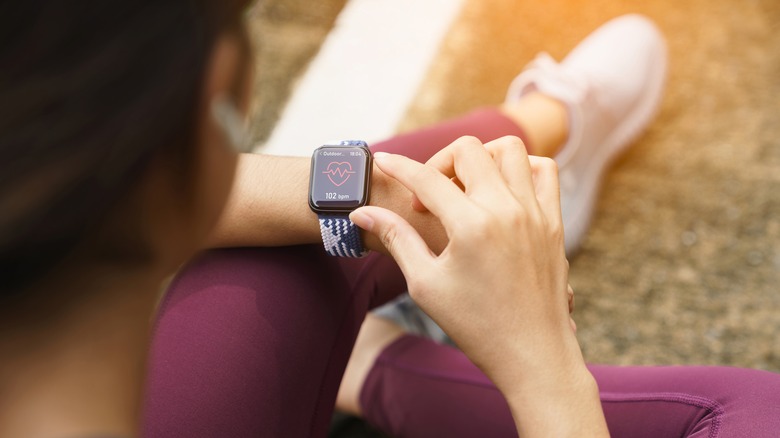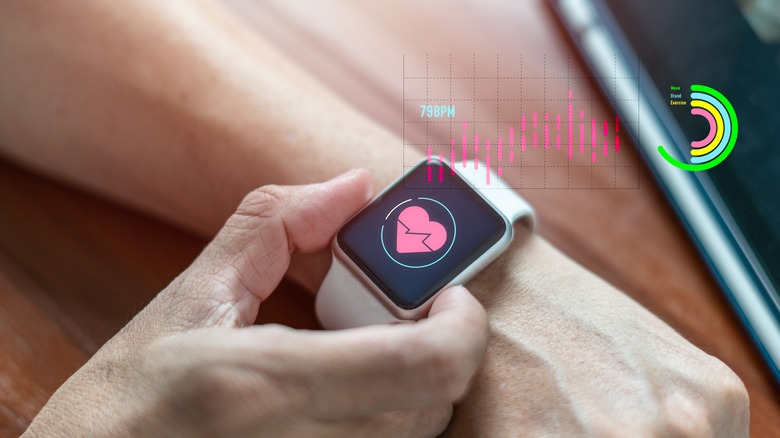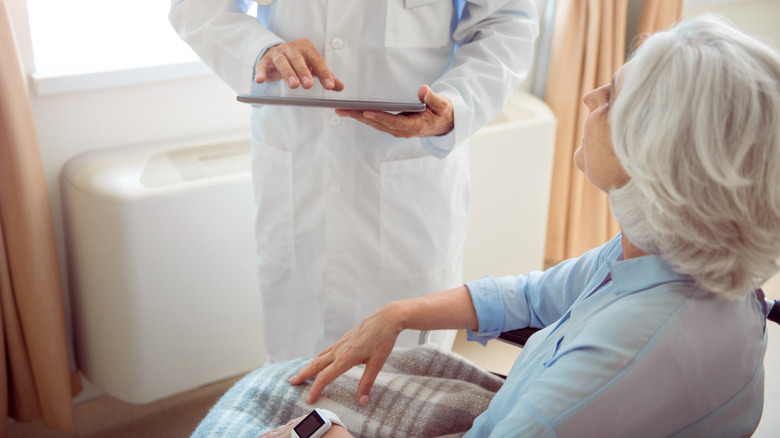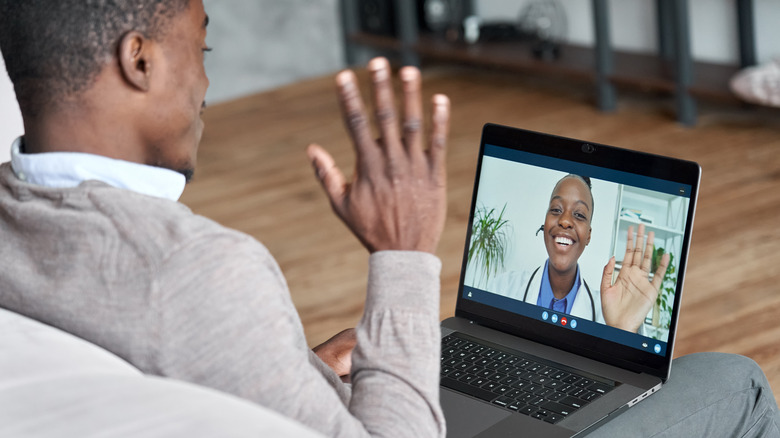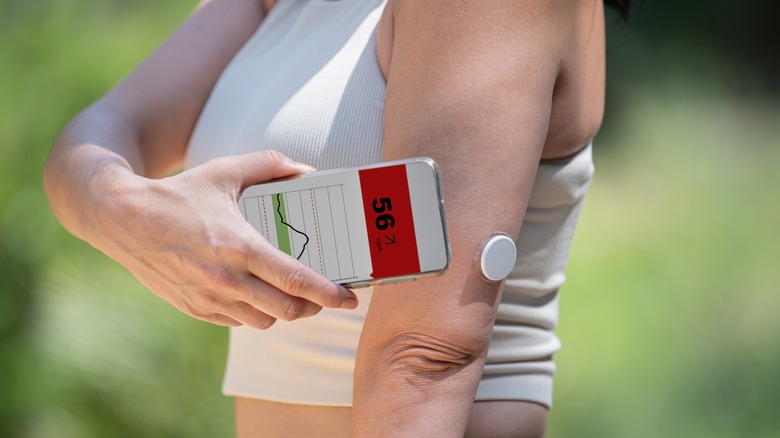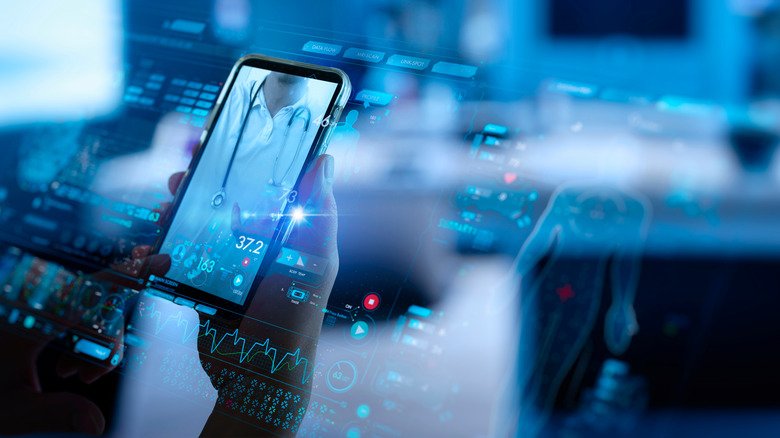Why Healthcare Wearables Are In Your Future
If you're not already part of the connected, real-time health checking crowd, then you soon will be. While healthcare wearables have been around for a while, the range of devices is expanding, as is the demand, and also who uses the information. You may enjoy monitoring your Fitbit or other fitness tracker, but in the future your doctor may be interested in your monitored health data too (via Insider Intelligence). An area that is definitely coming onto the radar is the role of insurance companies looking to monitor the health of policy holders (via AMA).
It makes sense that as tech capabilities grow, you may want to take more control and be more engaged in your own wellbeing. In fact, such is the popularity of these devices that in 2022, Insider Intelligence says that the number of smart wearable users in the U.S. is around a quarter of the population. And this trend is expected to rise. The source says that as companies realize the foresightedness of looking after the welfare of their employees in a more focused way, there will likely be greater interest from the corporate sector as well. After all, a healthier workforce is not only great for morale and productivity, but also reduces staff turnover as well. In the future, the different devices available will expand, along with their levels of accuracy as connectivity improves. What aspects of health are checked over will also become far wider, going beyond just blood pressure and ECG monitors.
Clinical-grade medical wearables are worth billions
According to a report by InsightAce Analytic, as reported by Yahoo! Finance, clinical-grade medical wearables are set to be worth $148.7 billion by 2030. The focus here is on patient care and there are plenty of advantages to the data these devices provide. They are able to monitor and analyze continuously over a long time. That means that there's greater scope for results that relate to not just what's happening at any given time, but also for an extended period. What these wearables have in common is that they collect data and send it digitally so that it can be assessed remotely.
This obviously has financial implications, in that wearables could take some economic burden off of health systems if some of the checks are being carried out at home by the patient. With so much data, there could be huge benefits in terms of diagnosing ailments, not just monitoring them, and making decisions about treatment. Early detection rates can reduce the burden of illness on patients and society as a whole. There is certainly a lot of scope for using wearables in relation to a number of health issues, ranging from diabetes to asthma and hypertension. If you imagine the costs of these illnesses on every level, then the cost of wearable technology is potentially a small price to pay in the future. According to a Forbes article, wearables could save the health sector $200 billion globally over the next couple of decades.
Wearables are part of telehealth care
In an interview in Forbes, Patrick Baker, CEO of Palarum, highlights how the possibilities of wearables extend beyond monitoring health. They have a pivotal role to play in the future of telehealth too, including how patients are looked after once they return home from a hospital setting, and also how their needs are met on a ward as well. The company's PUP® (Patient Is UP) Smart Sock lets medical professionals know when a patient who's at risk of falling is up and out of bed. It's clear that there's real potential for wearables in providing greater care at home as well as a clinical environment such as a hospital or rehabilitation center.
Healthcare IT News highlights how telehealth, such as virtual doctor appointments, was forced to the fore during the pandemic. As this situation eases, there's now an opportunity to build on this healthcare structure with other remote elements, including wearables. With 5G technology and advancements in the number and capabilities of devices and how they connect up, wearables are likely to become an integral part of a number of care packages. As individuals become more knowledgeable about health and fitness, this is likely to further boost the familiarity of being involved more closely with your own physical status. Part of this increased uptake in wearable technology will undoubtedly rest on how to encourage older people to adopt these devices. Currently, the rate of wearable use by seniors is considered low (via NCBI).
Remote patient monitoring is developing
One of the latest developments in terms of monitoring the health of patients in and beyond hospital is the partnership between global healthcare tech leader, Medtronic, and medical wearable company BioIntelliSense. The August 2022 agreement means that distribution in the U.S. is assured for the BioButton®. This medical-grade wearable measures a whole host of data from respiratory rates to skin temperature. It's not just the gathering of information that is important either, but also how that data can be analyzed and ultimately inform decisions. For example, it may signify that a patient is doing well enough to continue care at home. Discharge may also be possible earlier because of this extra level of analysis. Likewise, if a patient's condition worsens, this could also be picked up on via the wearable.
The American Hospital Association reveals how there's substantial data to suggest that hospitals in the U.S could face a staff shortage crisis. It's forecast that this number could reach a shortfall of over 3 million healthcare workers in the U.S. by 2026. With this stark situation looming, the support of wearable devices that can assist in the flow of hospital stays more effectively and offer extra care in the home could be a welcome relief. It seems as if wearables are connecting not only data, but providing the format for new healthcare systems at the same time.
Lingo talks the language of diabetes healthcare
According to the American Diabetes Association, 37 million people have diabetes in the U.S. and it's fast become a huge medical issue and burden, costing $327 billion in 2017. Part of dealing with diabetes involves individuals monitoring what they eat and drink, as well as their activity levels. The very nature of the disease requires action on the part of the person who has it, rather than simply intervention by a medical professional. It's therefore apt that wearables are being developed that make tackling this health problem more accessible and potentially easier. This takes some of the burden off both the patient and health resources.
A big name in the wearable field is Abbott, and at the start of 2022 it was announced that a biowearable device called Lingo was being developed for those with diabetes. Biosensing technology is used to not only measure glucose levels, but also lactate and ketones. This follows the a device launched by the health company in 2014 for a wearable glucose monitor sensor that's worn on the arm and feeds back information to your smartphone. It's not just diabetics who can benefit from checking glucose either, as this could have an impact on other wellness issues such as sleep quality and energy levels. Abbott has also taken biowearables into the athletic performance arena too.
Wearables are in your future
From healthcare responsibilities at home, to remote monitoring of individuals under medical care, wearable devices cover a wide range of health issues. For example, Cision PR Newswire points out that they may measure your oxygen levels, heart activity, sleep, or be used to look at the health of an unborn baby. Other areas include pain management and neurostimulation. These wearables can aid in rehabilitative processes, along with therapy such as respiratory devices. In terms of how they're designed, the source details that some are clipped on or simply worn, while others may be handheld or even a sensor in your shoe.
The technology for smartwatches continues to progress, with Apple revealing in September 2022 that the Apple Watch Series 8 would focus on women's health (via Ars Technica). With two temperature sensors, the idea is that women will be able to track their cycles, or any changes within them. According to Chicago Health, beyond watches and jewelry, there's also going to be more patches providing stick-on monitoring. An example is TempTraq, which offers continuous temperature monitoring for 72-hours with a disposable patch that's non-invasive and wireless. Chicago Health also says that implantables and smart clothing are also likely to be advanced, including smart bras that help in the detection of breast cancer. Meanwhile, in Australia funding has been secured to enable the manufacturing of a patch to vaccinate people in the future (via Med-Tech). The scope of what wearables can achieve is incredible.

